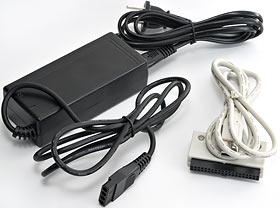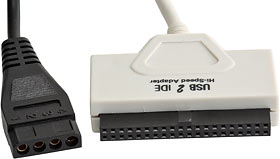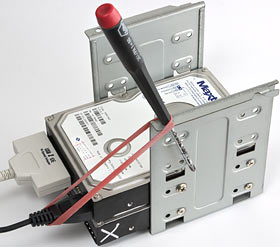
USB 2.0 to IDE Cable
Review date: 12 September 2004. Last modified 03-Dec-2011.
USB adapters for ATA (a.k.a. IDE) devices are useful things. If you find yourself in need of hundreds of gigabytes of portable storage that you can plug into pretty much any computer you come across and, assuming it's a reasonably recent computer running a reasonably recent operating system, Just Use It without installing drivers, then USB-to-ATA adapters are about as close as you'll get.
USB adapters will also let you turn a basically worthless old medium capacity drive (20Gb or less) into carry-around storage which beats any expensive little laptop-drive or Flash memory alternative. Bulkier, yes, particularly when you include the AC adapter as well as the drive itself (USB power's only good for 2.5 watts, which isn't enough to spin up most desktop drives), but you can't beat the price.
And these days, USB adapters are also, allegedly, likely to work with CD and DVD burners. Need to burn the occasional disc with your middle-aged laptop? Don't drop big dollars on the slimline installs-in-a-bay burner (assuming one's even available; tiny subnotebooks, in particular, may only support external drives) unless you really need your drive to be tiny. Buy a cheap Parallel ATA desktop drive instead (none of these adapters seem to support Serial ATA yet, which is fair enough since there is as yet very little reason for them to), and a USB adapter, and you're in business.
Well, as long as the darn thing works, anyway. Old USB adapters only worked OK with optical devices in read, mode and tended to create all kinds of hangs and crashes if you tried to write. Buying adapter and drive from a local store, and getting them to guarantee they'll refund your money if the combination worketh not, is still the way to go if you need a burner.
USB-to-ATA adapters are also a bit less attractive when you find yourself stuck with a computer that's only got a USB 1 controller in it. You can shift a couple of dozen megabytes per second through USB 2.0, but USB 1 tops out at about one megabyte per second, which isn't quite fast enough for even "1X" DVD burning, and is only enough for 4X CD burning. It'll leave you waiting a long, long time if you've got gigabytes of data to move. But that's not the drive's fault; at least you can move the data at some speed.
If you find yourself looking at a file transfer dialog that's telling you your hundred gigabytes of public domain Three Stooges movies is going to take 30 hours to shift to an older machine, though, there are two alternatives. One, go and buy a PCI USB 2.0 adapter card for the PC (nice and cheap for PCI, even in Australia;, fairly cheap for CardBus). Two, if it's a PC, unhook your USB adapter from your PATA drive, pop the lid on the computer, and hook the drive up directly. This last is, of course, still the data-swapping solution of choice for the real skinflint; elegant it ain't, but the old one about the station wagons full of tapes has been well and truly eclipsed, these days, by the new one about the kid on the Go-Ped with a backpack full of eBay hard drives.
Getting back to the subject - as well as USB adapters, there are FireWire-to-ATA adapters (popular in the Mac world, less so on PCs), and adapters that offer USB and FireWire. But your basic USB-2.0-capable adapter will do, for pretty much all purposes.
I've reviewed these sorts of things before - most recently, WiebeTech's ComboDock (USB 2.0 and FireWire 800), and an SNT box that offers USB and plain old FireWire 400, and costs quite a lot less than the aluminium clad, boxless ComboDock.
If all you want is USB 2.0, though, and you're happy with a "naked drive" solution like the WiebeTech Docks (no protection for the drive, but easy switching of the adapter between multiple devices - handy for backups!)...
...then this might appeal.
It's the melodically named "USB 2.0 to IDE Cable", and it came to me from USB Geek.com, who sell it for a princely $US32. So you could buy five of these things for the price of one ComboDock, or stock up on a bunch of other USB gadgets for the same money - USB Geek sell a pretty good selection of gadgets, including the Wireless PC Lock I reviewed the other day.
Who makes this drive adapter? You got me. This is one of those brandless chameleon products, and it doesn't even come with a manual. The box has "R-Driver" printed on it in one place, but that ain't no brand I can find.
What you get for your small amount of money is a two-piece kit; one USB adapter, and one power adapter.
They terminate in a couple of connectors that you don't often see coming out of moulded plugs.
The USB adapter has a plain old rectangular Type A plug on the other end of its three foot (91cm) cable, and can be used by itself if you run your drive from some other power supply (like a bare ATX supply with the green wire on the main plug jumpered to a black wire to get the PSU to power up, or a spare plug from a power supply in a computer with its side panel removed, or an old AT PSU). The power adapter can also be used by itself, too, if whatever you're plugging it into doesn't exceed the two amp limit on the +5V and +12V rails it provides.
The power adapter runs from a standard plug-in figure-8 cable, and you can get the kit with three kinds of mains cable plug. None of them are the Australian "/ \" pin standard, but Aussies can get the flat-pin version (or "Flated Pin", as it says in the USB Geek drop-down menu...) and just twist the pins out with a pair of pliers, if they're too cheap to get a plug adapter. I've done that before, and I did it this time; it worked fine. I imagine that doing this with gear you intend to resell will, in most jurisdictions, get you locked up for one million years.
The power adapter, like many these days, is a world-compatible unit (100 to 240 volts, 50 or 60Hz) that should work anywhere with just a pin converter or replacement figure-8 cable. Nobody should need a step-up or step-down transformer.
There is, as mentioned above, no manual, but you hardly need one. About the only way you can go wrong with the setup of this thing is by not jumpering the ATA drive to Master mode when you connect it. Like every other USB adapter kit out there, this one turns your ATA device into a USB Mass Storage device, which should work without extra drivers in every somewhat recent version of Windows and Mac OS, and may or may not work right in Linux. Most of these things come with a driver disk for Windows 98SE users; this one doesn't. Deal with it.
Trying it out
Hooking up USB adapters of all sorts is easy enough - as mentioned above, all you have to do is make sure the drive's jumpered in Master mode - but this one had some... character.
Drives spun up, and hiccupped, and spun up again, and then spun down, and many and varied were the errors thereby generated.
After a bit of fiddling, it became apparent to me that the problem was happening because the power adapter of my review kit has loose pins in its "Molex" plug; it doesn't make proper contact when it's just sitting there. Regular white nylon Molex plugs practically never have this problem (their major malfunction is refusing to let go, not failing to connect), but this special moulded plug had it, and gave me no easy way to cure it. The moulded plug makes it impossible to remove the pins, or just squish them a bit in situ.
I don't know how common this problem is among these things; USB Geek tell me they haven't seen it before. If you get an adapter that suffers from it, and a warranty replacement is for whatever reason not feasible (like, you bought your kit from USB Geek in Hong Kong and you live in another country) then you could either hack off the plug entirely and solder on a plain white nylon one (with only four wires, it'd be easy to identify them with a multimeter), or take a short male-to-female Molex lead (like the passthrough power adapters that come with many CPU coolers; just hack off the dangling fan power wire), brutalise the pins on the female plug until they firmly fit the power adapter plug, and glue that sucker on there.
Personally, I just rigged up a system based on advanced rubber band technology to pull the back of the power plug upwards...
...which worked perfectly for review purposes. In the course of doing this, by the way, I noticed that only one of the ground pins on the Molex plug seems to be connected to anything. This may or may not have something to do with the defect, but it's not a problem; the double ground pins are connected together on the drive, and just provide a bit of voltage drop reduction; they don't matter for a short-cabled single-plug setup like this.
(That other drive at the bottom of the cage in the above picture, incidentally, is only there because I haven't gotten around to making it a magnet donor yet. The "X" marks it for dismemberment.)
With a nice solid power connection, a 120Gb drive plugged into this adapter ripped along at 23 to 25 megabytes per second in USB 2.0 mode, for both reads and writes, when copying big files to and from the internal drives of my not-so-new test box. More than acceptable performance, and on par with other USB 2 adapters.
Next, I tried the adapter out with a DVD burner. Only an ancient (like, a year old) 4X unit, so as not to frighten it.
First, of course, I had to put up with the usual Windows new non-hard-disk USB device weirdness (reboot with device connected, see no new device, unplug device, replug device, Windows sees device, Windows installs device, Windows then wants you to reboot again for no clearly explained reason). After that, it was perfectly smooth sailing to an immaculate, expertly produced coaster.
At 4X, my first test burn of a full single layer DVD-R failed, with an error I've not previously seen, which makes me inclined to think it was the fault of the adapter and not a problem with the free-set-of-steak-knives-with-every-thousand-disc-spindle bargain basement media I was using. The burn hung at 64% complete, but Nero kept peacefully counting up the "Total time" and counting down the "Remaining time" until the latter reached zero, whereupon I gave up, since it didn't seem likely that the drive light was going to come on again.
I'd been doing a little light Web browsing in the background, but nothing else, and it was only a 4X burn anyway; with a modern PC you can pretty much defrag three drives at once while doing a 4X DVD burn and not have any problems. Even if the burner's buffer manages to run dry, it'll be able to stop and restart when it's got new data; the days when even CD burning had to be done without interruption are long gone.
One termination of the Nero process and precautionary reboot later, I re-tried that burn at 2X, and it was fine.
Then I did another 4X burn, with a different disc worth of files, studiously leaving the computer completely alone while it happened. This time it hung at 18%.
Once more at 4X, because my gluttony for punishment knows no bounds: This time it hung at 63%.
Again at 2X: A-OK.
I'm seeing a pattern, here.
I'm sure there are more than a few USB-ATA adapters around these days that work just fine with even high speed DVD burners, but I don't think you should count on this cheap one managing it.
Still, an adapter that only works at 2X ain't useless, particularly if you're not burning very many discs. Brand name new-old-stock 4X DVD-R drive on eBay? $US50 plus shipping. This adapter? $US32 plus shipping. Discs to suit? $US25 for a hundred. Giving your old laptop a new lease of life, including the ability to play DVDs just fine? Priceless.
Getting one
USB Geek's $US32 price for the USB 2.0 to IDE Cable doesn't include shipping, which most people could reasonably expect to be fairly expensive, since most people don't live in Hong Kong. It's not, though; shipping to anywhere in the world is $US3. And it's still $US3 no matter how much stuff you buy.
This suggests to me that USB Geek are building the real shipping price into the price of the product. But that ain't much anyway, so I don't see a problem.
Overall
If you want a box to protect your USB drive, you obviously don't want a mere adapter cable. USB Geek have a selection of boxes, as of course do plenty of other dealers, but they lack the plug-and-go, wires-in-the-air, Mad Max appeal of an adapter cable.
I'm ready to believe that most of these things don't have the intermittent power plug problem that mine exhibited, but even if the one you buy does, it's not the end of the world. The thing works fine for hard drives and non-uselessly for burners, and it gives you the core functionality of a WiebeTech DriveDock-type gadget for far less money. A lot of geeks have a use for a device like this only occasionally, and so can't justify spending a lot of money on it; for them, this cheap and cheerful adapter fits that niche perfectly.
Recommended.
Review USB 2.0 to IDE Cable kindly provided by USB Geek.com.





